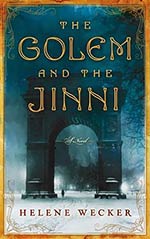
![]() Ryan_S
Ryan_S
10/3/2014
![]()
Helene Wecker's The Golem and the Jinni is a novel about quite a few things. On the surface, it is about the entwined fates of two mythical creatures. It is about conflicts of faith, both from outside and from within. It is about New York City, booming and bustling with immigrants during the early 20th Century. What it is about, to me at least, is about isolation. Even while the city streets were teeming with more and more folk at that time, there was a distinct sort of loneliness one could feel when being as far of an outsider as one could be in a new place. Wecker's novel details that loneliness, but also details the growing hope that comes with forging bonds.
Bonds are an important thing to keep in mind. In traditional Hebrew myth, a golem is a servitor made from earth and clay, brought to life through a mystical word written on the forehead of the creature. It has the appearance of a man, but has no true free will like a man would have. It is bound to whoever has written the word upon its form. In The Golem and the Jinni, the titular golem is, in a subversive turn, a woman created by a Kabbalist to be the bride of a man. This 20th Century Galatea is named Chava, and finds herself as though a newborn to the world around her, on account of her master dying before reaching New York City together. While I was less-than impressed by Wecker's loose understanding of traditional Kabbalah mysticism (being Jewish and a fan of the mystic world myself), the attention taken to the limited life a woman during that time period would have was actually very insightful to see.
Looking at the second part of the title, the jinn in question is named Ahmad. Literally named on the spot, I might add, for he is freed from an oil flask after hundreds of years, with no memories except for the knowledge that he was trapped inside of it by a wizard. Wecker gets the mythology down a bit better with Ahmad, for the jinn are not at all like the wish-granting genies that the Western world seems to have an image of. The Middle-Eastern spirit-creatures are beings of fire, capable of causing great havoc amongst humans if they feel inclined to it. Ahmad is bound to a mortal form, and he heads out to once again enjoy the pleasures of freedom. There's a strong juxtaposition between Ahmad and Chava. Ahmad is ancient, weary and cynical towards the world and its histories. Chava, in contrast, is as new to the environment around her as a newborn child would be. While neither of them fit into the city surrounding them as well as humans do, their paths cross and knit together. This bond is forged from the loneliness each of them experience in their respective lives, and (without spoiling a lot of the central plot) they come to learn much about their place in the world through one another.
There is, of course, more to the story than just Chava and Ahmad trying to survive. The lives that they impact, along with the lives that impact them, are detailed throughout. The elderly Rabbi who takes Chava in from the streets, the Syrian tinsmith who inadvertently freed Ahmad from his prison, nephews, merchants, heiresses, all are caught up in the loneliness the start of the 20th Century seemed to bring. Despite the nostalgic, longing tone Wecker uses to describe New York City, the people that inhabit her vision of it feel the sort of hollowness that their lives echo through. They are all seeking out their role in life, in one way or another. It can be argued that they are, in those regards, much like Chava or Ahmad. Robbed of an understanding of what purpose they serve, they all seek out ways to combat that nagging feeling of uncertainty.
As a fantasy, The Golem and the Jinni works very well for what it sets out to be. If Chava and Ahmad's journey was stripped away of its fantastical elements, then the story would be a mere tale about immigrants' struggles in a city that often did not care for them. While that would be an alright read on its own, it has been done before. Choosing to make the protagonists twice-removed from conventional citizenship (as both immigrants AND things that are not human) allows for the two to act in ways that a human immigrant most certainly would not have, if put in the same scenarios. Some flimsy research aside, Wecker works the fantastical elements of two creatures from myth into ways that just make sense in the world of the novel. Cultural identity was a large part of the immigrant way of life, and the cultures of Syrian and Jewish immigrants are shown, by and large, through the outsider eyes of Ahmad and Chava. Even though they are of each culture's beliefs, they themselves do not feel particularly inclined to believe back. Outsiders amongst outsiders, their fantastical elements works well amidst the wild commotion life in the poor slums was. I definitely recommend reading through The Golem and the Jinni, especially if one is a fan of the mystical traditions of cultures that have long-since been forgotten by the sands of time.